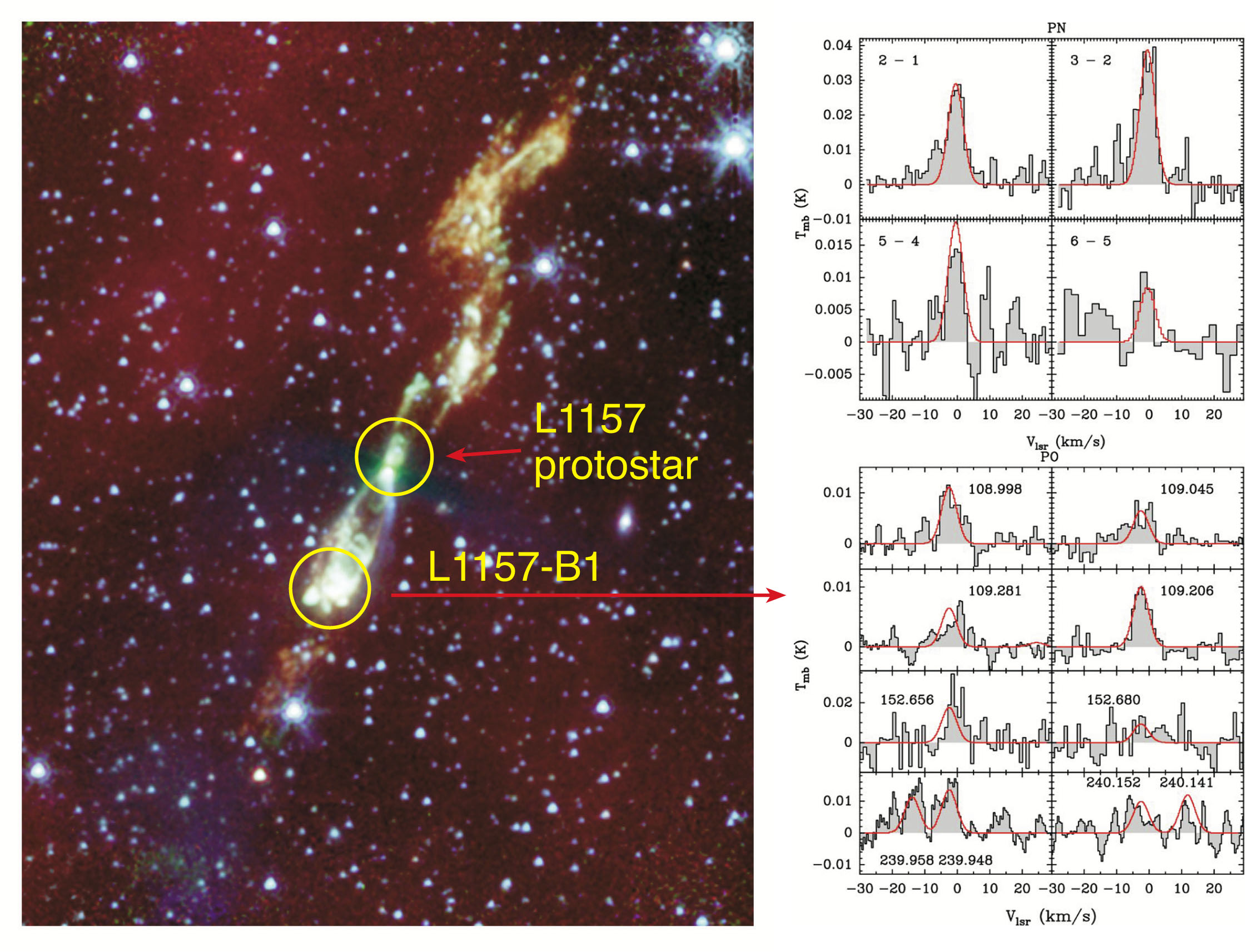News
IRAM reveals phosphorus molecular compounds in the solar-type star-forming region L1157
As part of the Large Program ASAI, the IRAM 30-meter radiotelescope was used to lead a systematic search for molecules containing phosphorus (P) towards L1157-B1, a shock wave front created by the propagation of a supersonic jet emanating from a solar-type protostar. Several spectral lines of phosphorus mononitride (PN) were detected and, for the first time in a solar-type star-forming region, the lines of phosphorus monoxyde (PO), a molecule of high biological interest. The study shows that the relative abundance of PO and PN can be used as a diagnostics of the gas in the shocked region, bringing constraints on parameters such as the shock velocity and its temperature.
Biogenic element
Despite a rather low elemental abundance, phosphorus is one of the main biogenic elements, present in all life forms on Earth. As such, phosphorus-bearing compounds, in particular molecules containing bonds between phosphorus and oxygen (P-O), play a key role in many biochemical and metabolic processes in living systems.
In our solar system, the presence of phosphorus has been recently reported in comet 67P/Churyumov–Gerasimenko (the comet visited by the Rosetta spacecraft), and phosphorus-bearing compounds also appear to be rather ubiquitous in meteorites. Several P-bearing molecules, like PN, PO, CP, HCP, PH3, and CCP, had been previously detected in the circumstellar and/or the interstellar medium. For instance, a recent study carried out also at IRAM provided the detection of PO in two high-mass star forming regions. However, searches for phosphorous compounds were unsuccessful towards solar-type star-forming regions, and only one line of PN was tentatively detected towards L1157-B1 until now.
Shock diagnostics
In the frame of ASAI (Astrochemical Surveys At IRAM), a Large Program led by B. Lefloch and R. Bachiller, the IRAM 30-meter telescope was used to explore the spectrum between 80 and 350 GHz towards two positions in the dark cloud named L1157 placed at about 800 light-years from Earth in the constellation of Cepheus. One position is that of the very young protostar dubbed L1157-mm from which a high velocity supersonic jet is emanating. The second position, named L1157-B1, corresponds to a bow-shaped shock wave front generated by the propagation of the jet. Such observations have allowed to unambiguously detect several rotational lines of PN and PO. These are the first firm detections of phosphorous compounds in a star-forming region of solar type stars. The emission of these species is restricted to the shocked region L1157-B1; no emission was detected towards the position of the protostar L1157-mm itself, and a search of PH3 was unsuccessful in both positions.
The authors derived the abundances of both PN and PO molecules and modeled the emission with numerical codes simulating the conditions in the shock and the chemical processes taking place in such extreme conditions. It follows that phosphorus is depleted by about a factor of 100 in the gas phase and that atomic nitrogen plays a key role in the formation and destruction routes of PO and PN. The PO/PN abundance ratio can be used as a powerful diagnostics of the shock properties, allowing to deduce that the duration of the pre-shock phase has to be close to one million years, the maximum temperature in the shock has to be larger than 4000 K, and the shock velocity 40 km/s.
Following up
Indeed it is very tempting to relate the presence of a molecule of high biological interest, as PO, in the region of formation of a solar-type star to the emergence of life. However it should also be pointed out that there are many and very complex chemical processes expected to take place from the formation of a star to the formation of a protoplanetary disk, the formation of planets, and the possible emergence of life. The assessment of some of such crucial processes is indeed the main goal of the ASAI project. Follow-up observations of PN and PO in L1157 at high angular resolution with the NOEMA array have just been completed in winter 2016-2017, and the data reduction is starting. By resolving the emitting regions of PO and PN, it will be possible to refine the model of formation and destruction of both molecules. So more exciting results are coming soon!
Read more:
Lefloch, Bachiller, et al. (2015) 'ASAI: The astrochemical evolution from interstellar clouds to young stellar objects', IAU GA Symposium 315.
Lefloch, Vastel, Viti, Jimenez-Serra, Codella, Podio, Ceccarelli, Mendoza, Lepine & Bachiller (2016) MNRAS, 462, 3937.




